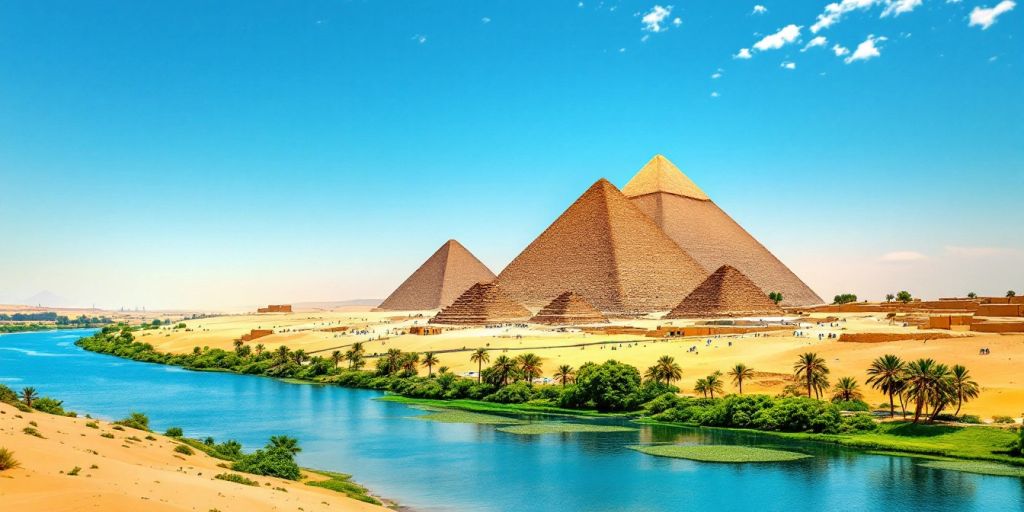Destinations
Egypt’s Top Attractions: From the Pyramids to the Nile

Egypt is a land of ancient wonders and rich history, attracting visitors from all over the globe. From the iconic Pyramids of Giza to the serene waters of the Nile, the country offers a diverse range of attractions that showcase its cultural heritage and natural beauty. Whether you are an adventure seeker or a history enthusiast, Egypt has something for everyone. Here are some key takeaways about Egypt’s top attractions that you shouldn’t miss during your visit.
Key Takeaways
- The Giza Pyramids are one of the Seven Wonders of the Ancient World and a must-see for every visitor.
- Luxor is often called the world’s greatest open-air museum, featuring stunning temples and tombs.
- The Nile River offers beautiful cruises that let you explore ancient sites from the water.
- Alexandria, with its relaxed vibe, contrasts sharply with the bustling cities of Cairo and Luxor.
- The Red Sea coast is famous for its incredible diving spots, making it a top choice for water sports enthusiasts.
1. Giza Pyramids
The Giza Pyramids are among the most iconic structures in the world, serving as the final resting places for ancient Egyptian pharaohs. These monumental tombs reflect the incredible engineering skills of the ancient Egyptians and their belief in the afterlife.
Key Features of the Giza Pyramids
- Pyramid of Khufu: The largest of the three, originally standing at 146.5 metres tall, it is made from approximately 2.3 million stone blocks.
- Pyramid of Khafre: Known for its well-preserved limestone casing at the top, it appears taller than Khufu’s due to its elevated location.
- Pyramid of Menkaura: The smallest of the three, yet still a remarkable feat of construction.
Interesting Facts
- The pyramids are aligned with incredible precision to the cardinal points: north, south, east, and west.
- The Sphinx, located nearby, has the face of Pharaoh Khafre and the body of a lion, symbolising strength and protection.
- The construction of these pyramids remains a mystery, with many theories but no definitive answers.
The Giza Pyramids stand as a testament to the ancient Egyptians’ architectural prowess and their deep spiritual beliefs. They continue to attract millions of visitors each year, eager to witness these wonders of the ancient world.
Visiting the Giza Pyramids
- Opening Hours: Daily from 8 AM to 5 PM.
- Entry Fee: Varies for Egyptians and foreigners.
- Guided Tours: Highly recommended for a deeper understanding of the history and significance of these structures.
In summary, the Giza Pyramids are not just tombs; they are a glimpse into the past, showcasing the grandeur of ancient Egyptian civilisation. Whether you are an archaeology enthusiast or a casual traveller, a visit to these pyramids is a must!
2. Sphinx
The Sphinx is one of Egypt’s most iconic symbols, standing guard near the Giza Pyramids. This magnificent statue features the body of a lion and the face of Pharaoh Khafre, representing strength and wisdom. It is about 20 metres tall and has two massive claws that stretch out in front of it.
Key Features of the Sphinx:
- Height: Approximately 20 metres
- Length: About 73 metres
- Material: Carved from limestone
The Sphinx has been a source of mystery and fascination for centuries. Here are some interesting facts:
- It is believed to have been built around 2500 BC.
- The Sphinx has a snake carved on its forehead, symbolising royalty.
- It has faced erosion over the years but remains a significant historical site.
The Sphinx has stood for thousands of years, watching over the pyramids and guarding the secrets of ancient Egypt.
Visiting the Sphinx is a must for anyone exploring Egypt, as it offers a glimpse into the grandeur of ancient civilisations and their architectural achievements.
3. Luxor Temple
The Luxor Temple is one of the most important ancient sites in Egypt, located on the east bank of the Nile River. This magnificent temple was built to honour the god Amun and is part of the larger Karnak Temple complex.
Key Features of Luxor Temple
- Obelisk of Ramses II: Standing at about 20 metres tall, this impressive structure is flanked by statues of pharaohs, showcasing the grandeur of ancient Egyptian architecture.
- Lotus Columns: Inside the temple, you will find 12 tall lotus columns arranged in two rows, symbolising the guardianship of the temple.
- Historical Inscriptions: The outer walls are adorned with colourful carvings that tell stories of the pharaohs and their achievements.
The Luxor Temple is often described as a living museum, where visitors can feel the ancient history surrounding them.
Visiting Luxor Temple
When visiting Luxor Temple, consider the following:
- Timing: Early morning or late afternoon visits offer the best light for photography.
- Guided Tours: Hiring a guide can enhance your understanding of the temple’s rich history.
- Nearby Attractions: Don’t miss the Karnak Temple, which is just a short walk away, making it easy to explore both sites in one day.
Luxor Temple is truly a must-see for anyone interested in ancient Egyptian culture and history, making it one of the top attractions in Luxor.
4. Karnak Temple
The Karnak Temple is one of the most impressive ancient sites in Egypt. Located near Luxor, it is part of the larger Theban temple complex. This temple is known for its vast size and intricate designs, making it a must-visit for anyone interested in ancient history.
Key Features of Karnak Temple
- Massive Columns: The temple features towering columns that reach up to 23 metres high, showcasing the architectural skills of the ancient Egyptians.
- Sacred Lake: A large lake within the temple grounds was used for rituals and ceremonies, reflecting the importance of water in ancient Egyptian culture.
- Amun-Ra: The temple is dedicated to the sun god Amun-Ra, and many inscriptions and carvings depict his significance in ancient Egyptian religion.
Visiting Tips
- Plan Your Visit: Arrive early to avoid crowds and enjoy the temple in peace.
- Guided Tours: Consider joining a guided tour to learn more about the history and significance of the temple.
- Photography: Bring a camera to capture the stunning architecture and beautiful surroundings.
The Karnak Temple complex is a testament to the ancient Egyptians’ architectural prowess and their deep spiritual beliefs. It remains a vital part of Egypt’s rich history, attracting visitors from around the world.
Overall, the Karnak Temple is a remarkable site that offers a glimpse into the grandeur of ancient Egyptian civilisation. Its vast ruins and intricate carvings tell stories of a time long past, making it a highlight of any trip to Egypt.
5. Valley of the Kings
The Valley of the Kings is a famous burial site located on the west bank of the Nile near Luxor. This valley is home to over 60 ancient tombs, including the well-known tomb of King Tutankhamun. Here are some key points about this remarkable site:
- Historical Significance: The Valley served as the burial ground for many pharaohs and nobles of the New Kingdom.
- Tomb Access: Not all tombs are open to the public; currently, only 18 are accessible at any given time.
- Artistic Features: The tombs are adorned with intricate frescoes depicting scenes from Egyptian mythology, including the Sun God and the Book of the Dead.
| Tomb Name | Pharaoh | Year Discovered |
|---|---|---|
| Tomb of Tutankhamun | Tutankhamun | 1922 |
| Tomb of Ramses II | Ramses II | 1881 |
| Tomb of Seti I | Seti I | 1817 |
Visiting the Valley of the Kings is a profound experience, allowing you to connect with the ancient history of Egypt. It’s essential to maintain a respectful silence while exploring these sacred sites, as they hold the memories of thousands of years.
In summary, the Valley of the Kings is not just a collection of tombs; it is a testament to the grandeur of ancient Egyptian civilisation and its beliefs about the afterlife. A visit here is a must for anyone interested in Egypt’s rich history.
6. Abu Simbel Temples
The Abu Simbel Temples are a remarkable sight in Egypt, built by Pharaoh Ramses II. These temples were created to honour the gods and showcase Ramses II’s power. At the entrance, you will find four enormous statues of Ramses II, which highlight his importance in ancient Egypt.
Key Features of the Temples
- Two Main Temples: The Great Temple of Ramses II and the Temple of Hathor.
- Architectural Marvel: Carved directly into the mountainside, showcasing incredible craftsmanship.
- Sun Festival: On February 11 and October 21, sunlight illuminates the inner sanctum, celebrating the Pharaoh’s birthday and death anniversary.
Visiting Abu Simbel
- Location: Situated near Lake Nasser, close to the Sudanese border.
- UNESCO World Heritage Site: Recognised for its cultural significance and architectural brilliance.
- Best Time to Visit: Early morning or late afternoon to avoid the heat and enjoy the stunning views.
The Abu Simbel Temples are not just a testament to ancient engineering but also a symbol of the wisdom of the ancient Egyptians. They reflect the grandeur of a bygone era and are a must-see for anyone visiting Egypt.
Summary
The Abu Simbel Temples are undoubtedly one of Egypt’s top attractions. They offer a glimpse into the past and are a perfect example of the ancient Egyptians’ architectural skills. Whether you are an enthusiast of history or just looking for breathtaking views, these temples will leave you in awe.
7. Temple of Philae
The Temple of Philae is a stunning ancient site located on an island in the Nile near Aswan. This temple is dedicated to the goddess Isis and is known for its beautiful architecture and rich history. It is often considered one of the last true Egyptian temples built in the country.
Key Features of the Temple:
- Location: Situated on Philae Island, accessible by boat.
- Architecture: Features intricate carvings and hieroglyphs that tell stories of ancient Egyptian mythology.
- Restoration: The temple was relocated to its current site in the 1960s to save it from rising waters due to the construction of the Aswan High Dam.
Visiting Tips:
- Best Time to Visit: Early morning or late afternoon to avoid the heat.
- Guided Tours: Consider joining a guided tour for deeper insights into the temple’s history.
- Photography: Bring a camera to capture the stunning views of the temple against the backdrop of the Nile.
The Temple of Philae is not just a site of historical significance; it is a place where the beauty of ancient Egypt comes alive, making it a must-visit for anyone exploring the region.
Overall, the Temple of Philae offers a glimpse into the rich cultural heritage of Egypt, making it a highlight of any trip to Aswan. Don’t miss the chance to experience this active tailor of history and beauty!
8. Nile River
The Nile River is the longest river in the world, stretching over 4,160 miles. It is often referred to as the "mother river" of Egypt, playing a crucial role in the country’s history and culture. Many visitors choose to embark on a Nile cruise, which offers a unique way to experience the stunning scenery and historical sites along the river.
Highlights of a Nile Cruise:
- Scenic Views: Enjoy breathtaking landscapes on both sides of the river.
- Historical Sites: Visit famous attractions like the temples of Karnak and Philae.
- Cultural Experiences: Engage with local Nubian villages and their rich traditions.
Activities on the Nile:
- Relax on the Deck: Take in the sunset while enjoying the tranquil waters.
- Dining and Entertainment: Savour delicious meals and watch traditional dance performances.
- Swimming and Leisure: Many cruise ships offer pools and bars for relaxation.
A Nile cruise is not just a journey; it’s an experience that connects you to the heart of Egypt’s ancient civilisation.
Whether you are exploring the temples or simply enjoying the view, the Nile River is a must-see for anyone visiting Egypt. It offers a blend of natural beauty and rich history that is hard to find anywhere else.
9. Grand Egyptian Museum
The Grand Egyptian Museum (GEM) is a must-visit for anyone interested in ancient Egypt. Set to open in early 2023, this museum will showcase over 100,000 artefacts, making it the largest archaeological museum in the world. Located just a stone’s throw from the Giza Pyramids, it offers a unique opportunity to explore Egypt’s rich history.
Key Features of the Museum
- Pharaoh Ramses II Statue: Standing at 11 metres tall, this statue greets visitors in the atrium.
- Tutankhamun’s Golden Mask: This stunning piece, made of gold leaf and inlaid with precious stones, is a highlight of the collection.
- Huff Sun Ship: A 4,000-year-old funerary boat, perfectly preserved, that measures 43 metres long.
Why Visit?
- Historical Significance: Each exhibit tells a story of ancient Egyptian civilisation.
- Unique Experience: The museum is designed to provide an immersive experience into the past.
- Cultural Heritage: It showcases the incredible achievements of the ancient Egyptians.
The Grand Egyptian Museum is not just a collection of artefacts; it is a journey through time, revealing the wonders of a civilisation that has fascinated the world for centuries.
10. Coptic Cairo

Coptic Cairo, also known as Old Cairo, is a fascinating area that showcases the rich history of Egypt’s Christian heritage. This neighbourhood is a must-visit for anyone exploring Cairo. Here, you can wander through narrow streets that feel like stepping back in time.
Key Attractions
- Hanging Church: An architectural wonder dating back to the 3rd century, adorned with beautiful Coptic art.
- Saint Sergius and Bacchus Church: A significant site believed to be where the Holy Family stayed during their time in Egypt.
- Coptic Museum: Home to a vast collection of Coptic artefacts, showcasing the history and culture of Egypt’s Christian community.
Visiting Tips
- Dress modestly: As this is a religious area, it’s important to respect local customs.
- Plan your visit: Allocate enough time to explore the various churches and museums.
- Engage with locals: Don’t hesitate to ask questions; the locals are often friendly and willing to share their knowledge.
Coptic Cairo is not just a place to visit; it’s an experience that connects you to the deep spiritual roots of Egypt.
In this vibrant area, you can also find the famous Khan El Khalili Bazaar, where you can shop for unique souvenirs and enjoy the lively atmosphere. Coptic Cairo truly offers a glimpse into the past, making it an essential stop on your Egyptian adventure.
11. Islamic Cairo
Islamic Cairo is a vibrant area filled with history and culture. This part of the city showcases stunning architecture and rich traditions. Visitors can explore ancient mosques, bustling markets, and beautiful streets that tell stories of the past.
Key Attractions
- Khan El-Khalili Bazaar: The largest open-air market in the Middle East, known for its colourful alleys and variety of shops.
- Al-Nasir Mosque: A magnificent mosque from the 14th century, showcasing intricate designs and Islamic art.
- Hanging Church: An architectural marvel that dates back to the 3rd century, famous for its beautiful Coptic art.
Visiting Tips
- Dress modestly when visiting religious sites.
- Bargain at the bazaar to get the best prices.
- Try local food at nearby cafes for an authentic experience.
Exploring Islamic Cairo is like stepping back in time, where every corner reveals a piece of history.
Whether you’re wandering through the Khan El-Khalili or admiring the Al-Nasir Mosque, this area is a must-visit for anyone wanting to experience the heart of Cairo.
12. Alexandria
Alexandria, located on Egypt’s northern coast, is a city rich in history and charm. It offers a unique blend of ancient and modern attractions that make it a must-visit destination. While it may not have the same ancient wonders as Cairo or Luxor, Alexandria is home to several fascinating sites:
Key Attractions
- Bibliotheca Alexandrina: A modern library that pays homage to the ancient Library of Alexandria, featuring a vast collection of books and manuscripts.
- Qaitbay Citadel: A 15th-century fortress built on the site of the ancient Lighthouse of Alexandria, offering stunning views of the Mediterranean Sea.
- Greco-Roman Landmarks: Explore the remnants of ancient temples and theatres that showcase the city’s rich history.
Beaches and Cafes
Alexandria is also known for its beautiful sandy beaches, which are often less crowded than those in other tourist hotspots. Here, you can relax and enjoy the sun. Additionally, the city boasts numerous charming cafes where you can savour local delicacies.
Alexandria is a city that feels different from the hustle and bustle of Cairo, making it a perfect spot for a more relaxed experience.
Summary Table of Key Attractions
| Attraction | Description |
|---|---|
| Bibliotheca Alexandrina | A modern library with a vast collection |
| Qaitbay Citadel | A historic fortress with stunning sea views |
| Greco-Roman Landmarks | Ancient sites showcasing rich history |
13. Al-Nasir Mosque
The Al-Nasir Mosque is a stunning example of Islamic architecture located in the heart of Cairo. Built in the 14th century, this mosque showcases the rich history of the Mamluk era with its tall minarets and intricate designs. Visitors can appreciate the beautiful exterior and the traditional Islamic art that adorns the structure.
Key Features of Al-Nasir Mosque:
- Historical Significance: A symbol of Cairo’s Islamic heritage.
- Architectural Beauty: Features stunning geometric patterns and traditional designs.
- Cultural Insight: Offers a glimpse into Egypt’s rich culture and history.
The Al-Nasir Mosque is not just a place of worship; it is a cultural landmark that reflects the artistic achievements of its time.
While visitors can admire the mosque from the outside, there may be specific rules regarding entry to the interior. It’s advisable to check these before planning your visit. The mosque is a must-see for anyone interested in Egypt’s architectural wonders and historical significance.
14. Khan El Khalili Bazaar
Khan El Khalili is Cairo’s signature shopping destination and the largest open-air market in the Middle East. This vibrant bazaar is a maze of colourful alleys filled with shops selling a variety of items, including:
- Handicrafts
- Clothing
- Jewellery
- Spices
If you love vintage items, there’s a special shop that offers magazines and vinyl records from the last century. Walking through the bazaar feels like stepping into a magical world, with each alley bursting with colour and life.
At the entrance, you’ll find Feshawi Cafe, a perfect spot to relax with a cup of coffee after shopping. As night falls, the market transforms with colourful lights, creating a mysterious atmosphere. You might even spot something as whimsical as Aladdin’s lamp hidden among the stalls.
The Khan El Khalili Bazaar is not just a market; it’s an experience that captures the essence of Egyptian culture and history.
15. Red Sea
The Red Sea is a stunning destination that attracts many visitors to Egypt. Known for its clear waters and vibrant marine life, it offers a variety of activities for everyone. Here are some highlights:
1. Diving and Snorkelling
- The Red Sea is famous for its incredible diving spots, such as Jackson Reef and Ras Mohammed National Park.
- You can see colourful coral reefs and a variety of fish, including sharks and dolphins.
- Many resorts, like Sharm El Sheikh, offer diving schools for beginners.
2. Beach Activities
- Enjoy sunbathing on beautiful beaches like Sharks Bay and Hadaba Beach.
- Try water sports such as paragliding, jet skiing, and windsurfing.
- Take a yacht trip to enjoy the sea and possibly spot dolphins.
3. Unique Landscapes
- The contrast of the desert and the sea creates breathtaking views.
- Explore the Coloured Canyon for its stunning rock formations and colours.
- Visit the Ras Mohammed National Park for its rich biodiversity.
The Red Sea is not just a place for relaxation; it’s a hub for adventure and exploration. Whether you’re diving deep or lounging on the beach, there’s something for everyone to enjoy!
16. Sharm El Sheikh
Sharm El Sheikh is a stunning resort town located on the southern tip of the Sinai Peninsula. This destination is famous for its beautiful beaches and vibrant nightlife. Visitors can enjoy a variety of activities, from relaxing on the beach to exploring the underwater world of the Red Sea.
Key Attractions
- Naama Bay: Known for its lively atmosphere, this area is filled with bars, restaurants, and nightclubs. It’s the perfect spot to enjoy a drink while watching the sunset over the Red Sea.
- Ras Mohammed National Park: A must-visit for nature lovers, this park is home to diverse marine life and stunning coral reefs. It’s ideal for snorkelling and diving.
- Coloured Canyon: A unique natural wonder, this canyon features beautiful rock formations and is perfect for hiking adventures.
Diving and Snorkelling
Sharm El Sheikh is renowned for its diving spots. Here are some popular locations:
| Dive Spot | Highlights |
|---|---|
| Jackson Reef | Known for its vibrant coral gardens and marine life. |
| Ras Um Sid Beach | Offers excellent snorkelling opportunities. |
| Sharks Bay Beach | A great place to relax and enjoy the sun. |
Sharm El Sheikh is not just about beaches; it’s a gateway to adventure and relaxation in one of Egypt’s most beautiful settings.
17. Hurghada

Hurghada is a stunning resort town located on the Red Sea, known for its beautiful beaches and vibrant marine life. This destination is perfect for those who love water activities. Diving enthusiasts flock here to explore the clear waters and colourful coral reefs.
Activities in Hurghada
- Snorkelling: Even if you don’t have a diving licence, you can enjoy snorkelling with professional instructors.
- Yacht Tours: Take a yacht out to sea, where you can enjoy delicious food while watching for dolphins.
- Water Sports: Try your hand at surfing, paragliding, or riding a water sofa for an adrenaline rush.
Marine Life
The Red Sea is home to a variety of marine species, making it a top spot for eco-travellers. Here are some highlights:
| Marine Life | Description |
|---|---|
| Tropical Fish | Brightly coloured and diverse |
| Coral Reefs | Stunning underwater gardens |
| Dolphins | Playful creatures often spotted |
Hurghada offers a unique blend of relaxation and adventure, making it a must-visit for anyone travelling to Egypt. Whether you want to relax on the beach or dive into the ocean, there’s something for everyone here!
18. Dahab
Dahab is a charming coastal town located on the Sinai Peninsula, known for its stunning beaches and vibrant underwater life. Once a sleepy Bedouin fishing village, it has transformed into a popular destination for tourists seeking adventure and relaxation.
Activities in Dahab
- Snorkelling and Diving: The clear waters of the Red Sea make Dahab a top spot for snorkelling and diving. You can explore beautiful coral reefs and encounter diverse marine life.
- Windsurfing and Kitesurfing: The consistent winds in Dahab attract water sports enthusiasts. Many schools offer lessons for beginners.
- Desert Adventures: Take a trip into the surrounding desert for camel rides or quad biking, experiencing the breathtaking landscapes.
Key Attractions
- Blue Hole: A world-famous diving site, known for its deep underwater sinkhole.
- Lagoon: A perfect spot for windsurfing, with shallow waters ideal for beginners.
- Mount Sinai: A short drive away, this mountain is famous for its religious significance and stunning sunrise views.
Dahab offers a unique blend of relaxation and adventure, making it a must-visit for anyone travelling to Egypt.
Whether you are looking to unwind on the beach or dive into the depths of the Red Sea, Dahab has something for everyone. Don’t miss the chance to experience its vibrant culture and breathtaking scenery!
19. Western Desert

The Western Desert is a stunning area in Egypt that many people love to explore. It offers a chance to enjoy nature and take part in exciting activities like camel rides, quad biking, and 4×4 desert safaris. Here are some highlights of this beautiful region:
Key Attractions
- White Desert National Park: Known for its unique white rock formations.
- Black Desert: Famous for its dark volcanic hills.
- Oases: Such as Siwa Oasis and Bahariya Oasis, which are rich in history and natural beauty.
Activities to Enjoy
- Camel Rides: Experience the desert like the ancient traders did.
- Quad Biking: Feel the thrill of speeding across the sandy dunes.
- Camping: Spend a night under the stars, enjoying the peacefulness of the desert.
The Western Desert is a place where you can truly connect with nature and escape the busy city life.
Whether you are looking for adventure or relaxation, the Western Desert has something for everyone. Don’t miss the chance to explore this magical part of Egypt!
20. Siwa Oasis
Siwa Oasis is a hidden gem in Egypt, known for its stunning landscapes and rich culture. This oasis is famous for its natural beauty and historical significance. Located in the Western Desert, it offers a unique experience away from the bustling cities.
Key Attractions
- Cleopatra’s Bath: A natural spring where visitors can relax and enjoy the warm waters.
- Shali Fortress: An ancient mud-brick fortress that provides a glimpse into the past.
- Oracle Temple of Amun: A historical site where ancient Egyptians sought guidance from the oracle.
Activities to Enjoy
- Explore the Desert: Take a jeep safari to discover the surrounding sand dunes.
- Visit Local Markets: Experience the vibrant culture by shopping for handmade crafts.
- Enjoy Stargazing: The clear desert skies offer a perfect view of the stars at night.
Siwa Oasis is not just a destination; it’s an experience that connects you with nature and history.
Quick Facts
| Feature | Details |
|---|---|
| Location | Western Desert, Egypt |
| Best Time to Visit | October to April |
| Unique Flora & Fauna | Date palms, desert foxes |
Siwa Oasis is a perfect getaway for those looking to escape the ordinary and immerse themselves in a unique environment.
21. White Desert
The White Desert in Egypt is a stunning natural wonder that captivates visitors with its unique landscape. This area is filled with snow-white sand and large white rock formations that have been shaped by years of weathering.
Key Features
- Breathtaking Scenery: The vast expanse of white sand and the towering rock sculptures create a magical atmosphere, especially under the bright sun.
- Night Sky: At night, the desert transforms into a star-gazing paradise, free from light pollution, allowing visitors to see the Milky Way clearly.
- Camping Experience: Visitors often set up tents and enjoy campfires, sharing stories and enjoying delicious meals under the stars.
Activities to Enjoy
- Camel Rides: Explore the desert on a camel, experiencing the beauty of the landscape from a different perspective.
- Photography: Capture the stunning contrasts of the white sand against the blue sky, especially during sunrise and sunset.
- Stargazing: Spend the night watching for shooting stars and making wishes in this serene environment.
The White Desert is a place where nature’s beauty shines, offering a peaceful escape from the busy world.
In summary, the White Desert is a must-visit for anyone looking to experience the tranquillity and stunning beauty of Egypt’s natural landscapes.
22. Black Desert

The Black Desert is a unique and stunning part of Egypt’s Western Desert. It is known for its dark volcanic hills and striking landscapes. Visitors often find themselves mesmerised by the contrast between the black mountains and the golden sands.
Key Features
- Volcanic Hills: The hills are made of black basalt, giving the desert its name.
- Stunning Views: The scenery is breathtaking, especially during sunrise and sunset.
- Adventure Activities: Visitors can enjoy activities like camel rides and 4×4 safaris.
Why Visit?
- Natural Beauty: The Black Desert offers a peaceful escape from city life.
- Unique Experience: It’s a chance to see a different side of Egypt’s landscape.
- Photography Opportunities: The contrasting colours make for amazing photos.
The Black Desert is a place where nature’s beauty shines, offering a tranquil retreat for those seeking adventure and peace.
Tips for Visitors
- Stay Hydrated: Bring plenty of water, as the desert can be very hot.
- Dress Appropriately: Wear light clothing and sturdy shoes for walking.
- Plan Your Trip: Consider joining a guided tour for a safer experience.
In summary, the Black Desert is a must-visit for anyone looking to explore Egypt’s diverse landscapes. It’s a place where you can connect with nature and enjoy the serenity of the desert.
23. Temple of Horus at Edfu
The Temple of Horus at Edfu is one of the most remarkable ancient sites in Egypt. This temple is dedicated to the god Horus and is known for being the best-preserved ancient Egyptian shrine. Built between 237 and 57 BC, it showcases stunning architecture and intricate carvings that tell stories of the ancient gods.
Key Features
- Architecture: The temple is built in the classic Egyptian style, featuring massive stone walls and towering columns.
- Reliefs: Inside, you can find detailed reliefs depicting the life of Horus and various ancient rituals.
- Sacred Lake: The temple complex includes a sacred lake, which was used for purification rituals.
Visiting the Temple
When visiting the Temple of Horus, consider the following:
- Guided Tours: Opt for a guided tour to fully appreciate the history and significance of the temple.
- Photography: Capture the stunning architecture, but be mindful of the rules regarding photography.
- Timing: Visit early in the morning or late in the afternoon to avoid crowds and enjoy cooler temperatures.
The Temple of Horus at Edfu stands as a testament to the ingenuity of ancient Egyptian builders and their devotion to their gods. It remains a must-see for anyone exploring Egypt’s rich history.
24. Kom Ombo Temple
The Kom Ombo Temple is a unique site located on the banks of the Nile. This temple is special because it honours two gods: the falcon god Horus and the crocodile god Sobek. Visitors can still see the original colours of the temple, which have remarkably stood the test of time!
Key Features
- Double Temple Design: The temple is divided into two halves, each dedicated to a different deity.
- Ancient Inscriptions: The walls are adorned with fascinating carvings and inscriptions that tell stories of ancient Egyptian life.
- Crocodile Mummies: Nearby, you can find mummies of crocodiles, which were sacred to Sobek.
Visiting Tips
- Best Time to Visit: Early morning or late afternoon to avoid the heat.
- Guided Tours: Consider joining a guided tour for deeper insights into the temple’s history.
- Photography: Bring a camera to capture the stunning architecture and beautiful surroundings.
The Kom Ombo Temple is not just a place of worship; it is a window into the past, showcasing the rich history and culture of ancient Egypt.
Overall, the Kom Ombo Temple is a must-see for anyone exploring Egypt, offering a glimpse into the fascinating beliefs and practises of the ancient Egyptians.
25. Elephantine Island and more
Exploring Elephantine Island
Elephantine Island is a beautiful spot located in the Nile near Aswan. This island is rich in history and culture. Visitors can stroll through its charming Nubian villages, where the vibrant colours and friendly locals create a warm atmosphere. Here are some highlights of what you can do on the island:
- Visit the ancient ruins of the Temple of Khnum.
- Explore the Aswan Museum, which showcases local history.
- Enjoy a traditional meal at a local Nubian restaurant.
Activities on the Nile
The Nile River offers various activities for tourists. A popular choice is taking a felucca cruise, which allows you to relax and enjoy the stunning views. Here are some activities you can consider:
- Felucca rides for a peaceful experience on the water.
- Fishing trips to catch local fish.
- Sunset cruises for breathtaking views as the sun sets over the river.
Local Cuisine
When visiting Elephantine Island, don’t miss out on trying the local food. Here are some dishes to look for:
- Koshari: A mix of rice, lentils, and pasta topped with tomato sauce.
- Ful Medames: A dish made from fava beans, often served for breakfast.
- Nubian bread: A traditional bread that pairs well with many meals.
Elephantine Island is not just a place to visit; it’s an experience that connects you to the heart of Egypt’s culture and history.
In summary, Elephantine Island and its surroundings offer a unique blend of history, culture, and natural beauty, making it a must-visit destination in Aswan. Whether you’re exploring ancient sites or enjoying the local cuisine, there’s something for everyone to enjoy!
Final Thoughts on Egypt’s Wonders
In conclusion, Egypt is a land filled with incredible sights and rich history. From the iconic Pyramids of Giza to the serene Nile River, there is so much to see and do. Each location tells a story of ancient times, making it a fascinating place for visitors. Whether you’re exploring the bustling streets of Cairo or relaxing by the Red Sea, Egypt offers a unique experience that stays with you long after your visit. So, if you’re planning a trip, make sure to include these top attractions in your itinerary for an unforgettable adventure.
Frequently Asked Questions
What are the top places to see in Egypt?
If you’re short on time, don’t miss the Giza Pyramids, the Sphinx, and the ancient temples in Luxor.
When is the best time to visit Egypt?
The ideal time to visit is between October and April when temperatures are cooler.
Can I enter the Pyramids?
Yes, visitors can go inside the Giza Pyramids, but there’s not much to see inside.
What is the Grand Egyptian Museum?
It’s the largest archaeological museum in the world, showcasing thousands of ancient Egyptian artefacts.
What activities can I do on the Nile?
You can take a cruise, enjoy felucca rides, or visit various ancient sites along the river.
Is Alexandria worth visiting?
Yes, Alexandria offers beautiful beaches, historical sites, and a relaxed atmosphere.
What is the best way to explore Luxor?
You can explore Luxor by foot, or take a hot air balloon ride for stunning views of the temples.
Are there good diving spots in Egypt?
Absolutely! The Red Sea is famous for its vibrant coral reefs and excellent diving opportunities.
-

 Business6 days ago
Business6 days agoWall Street Rallies as Strong Jobs Report Fuels Optimism
-

 Business5 days ago
Business5 days agoS&P 500 Achieves Historic Winning Streak Amid Easing Trade Tensions
-

 Government5 days ago
Government5 days agoSupreme Court Case Martin V. USA: A Landmark Moment for Government Accountability in Wrong-House Raids
-

 Civil Rights7 days ago
Civil Rights7 days agoUS Government Under Fire for Wrong-House Raids: Accountability at Stake
-

 Health & Fitness4 days ago
Health & Fitness4 days agoBudget Cuts Slash Vital Health-Tracking Programs in the U.S.
-

 Business3 days ago
Business3 days agoUS Stock Market Soars on Positive Jobs Data and Trade Optimism
-

 Business4 days ago
Business4 days agoUS Stock Market Soars as Jobs Report Surprises and Trade Tensions Ease
-

 Crime5 days ago
Crime5 days agoU.S. Treasury Takes Aim at Major Mexican Cartel Linked to Fentanyl Trade












